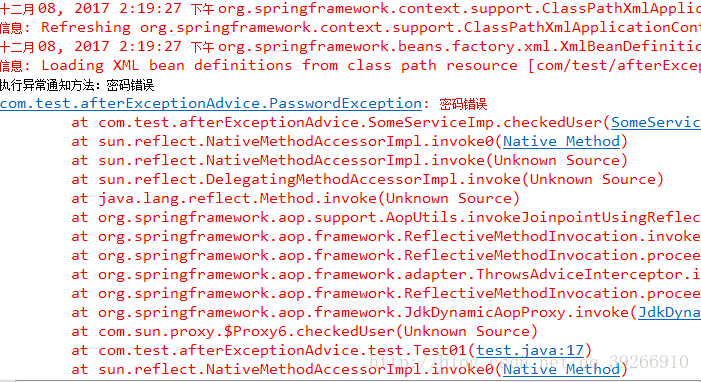08 Spring框架 AOP (一)
首先我们先来介绍一下AOP:
AOP(Aspect Orient Programming),面向切面编程,是面向对象编程OOP的一种补充。
面向对象编程是从静态角度考虑程序的结构,面向切面编程是从动态的角度考虑程序运行过程。
AOP底层,就是采用动态代理模式实现的。采用两种代理:JDK的动态代理,与CGLIB的动态代理。
JDK的动态代理是面向接口的,CGLIB既可以实现有接口的,又可以实现没有接口的。(对动态代理不了解的可以看看我的其关于动态代理的介绍)
面向切面编程,就是将交叉业务逻辑封装成切面,利用AOP容器的功能将切面植入到主业务逻辑中。所谓交叉业务逻辑是指:通用的,与主业务逻辑无关的代码,如安全检查,事务日志等。
Spring的AOP的几种用法:
通知:即我们的切面方法
- 前置通知
- 后置通知
- 环绕通知
-
异常通知
(一)前置通知
所谓前置通知,就是这个切面方法在我们的主业务方法之前执行。
首先我们先写一个目标接口:
//目标接口 public interface SomeServices { String doFirst(); void doSecond(); }
//接口实现类,也就是主业务方法类 public class SomeServiceImp implements SomeServices{ @Override public String doFirst() { System.out.println("print first"); return null; } @Override public void doSecond() { System.out.println("print second"); } }
//切面方法,需要实现:**MethodBeforeAdvice** 接口 public class myBeforeMethodAdvice implements MethodBeforeAdvice { //method:业务方法 //args:方法参数 //target:目标类 @Override public void before(Method method, Object[] arg1, Object target) throws Throwable { System.out.println("执行主业务前方法"); } }
<!--Spring主配置文件--> <bean id="service" class="com.test.beforeMethodAdvice.SomeServiceImp"/> <bean id="myAdvice" class="com.test.beforeMethodAdvice.myBeforeMethodAdvice"/> <bean id="ProxyService" class="org.springframework.aop.framework.ProxyFactoryBean"> <property name="target" ref="service"/> <!--<property name="target" value="service"/>--> <property name="interceptorNames" value="myAdvice"/> </bean>
接着是测试方法:
public class test { @Test public void Test01() { String source = "com/test/beforeMethodAdvice/applicationContext.xml"; ApplicationContext ac = new ClassPathXmlApplicationContext(source); SomeServices service = (SomeServices)ac.getBean("ProxyService"); service.doFirst(); service.doSecond(); } } //控制台输出: //执行主业务前方法 //print first //执行主业务前方法 //print second
(二)后置通知
后置通知和前置通知雷同,只是切面方法的实现类不同,但是后置通知实现接口方法,多给用了一个returnValue参数,也就意味着我们可以获得主业务方法的返回值,我们来看看范例:
//主业务接口 public interface SomeServices { String doFirst(); void doSecond(); }
//主业务方法实现类,doFirst()有返回值 package com.test.afterMethodAdvice; public class SomeServiceImp implements SomeServices{ @Override public String doFirst() { System.out.println("print first"); return "abc"; } @Override public void doSecond() { System.out.println("print second"); } }
//实现了**AfterReturningAdvice** 接口,实现这个接口的方法有一个返回值参数 public class myAfterMethodAdvice implements AfterReturningAdvice { //returnValue:业务方法的返回值 //method:业务方法属性类 //args:方法参数 //target:目标类 @Override public void afterReturning(Object returnValue, Method method, Object[] args, Object target) throws Throwable { System.out.println("执行业务后方法"); //只能获取到业务方法的返回值,但是不能进行修改 System.out.println(returnValue); }
<!--配置文件没什么差别--> <bean id="service" class="com.test.afterMethodAdvice.SomeServiceImp"/> <bean id="myAdvice" class="com.test.afterMethodAdvice.myAfterMethodAdvice"/> <bean id="ProxyService" class="org.springframework.aop.framework.ProxyFactoryBean"> <property name="target" ref="service"/> <!--<property name="targetName" value="service"/>--> <property name="interceptorNames" value="myAdvice"/> </bean>
测试方法:
public class test { @Test public void Test01() { String source = "com/test/afterMethodAdvice/applicationContext.xml"; ApplicationContext ac = new ClassPathXmlApplicationContext(source); SomeServices service = (SomeServices)ac.getBean("ProxyService"); service.doFirst(); service.doSecond(); } } //print first //执行业务后方法 //abc //print second //执行业务后方法 //null
(三)环绕通知
环绕通知就是既能实现前置通知又能实现后置通知,但是不同的是它能够对主业务方法进行修改。
//主业务接口 public interface SomeServices { String doFirst(); void doSecond(); }
//主业务方法实现类 public class SomeServiceImp implements SomeServices{ @Override public String doFirst() { System.out.println("print first"); return "abc"; } @Override public void doSecond() { System.out.println("print second"); } }
//环绕通知,切面方法类,需要实现**MethodInterceptor** //并且调用参数的proceed方法,这个方法有一个返回值,也就是主业务方法的返回值,我们可以对它进行修改。 public class MyMethodInterceptor implements MethodInterceptor { @Override public Object invoke(MethodInvocation invocation) throws Throwable { System.out.println("环绕通知,业务方法前"); Object result = invocation.proceed(); System.out.println("环绕通知,业务方法后"); if(result != null) { result = ((String)result).toUpperCase(); } return result; } }
//环绕通知的配置文件 <bean id="service" class="com.test.MethodInterceptor.SomeServiceImp"/> <bean id="myAdvice" class="com.test.MethodInterceptor.MyMethodInterceptor"/> <bean id="ProxyService" class="org.springframework.aop.framework.ProxyFactoryBean"> <property name="target" ref="service"/> <property name="interceptorNames" value="myAdvice"/> </bean>
//测试方法: public class test { @Test public void Test01() { String source = "com/test/MethodInterceptor/applicationContext.xml"; ApplicationContext ac = new ClassPathXmlApplicationContext(source); SomeServices service = (SomeServices)ac.getBean("ProxyService"); String result = service.doFirst(); System.out.println(result); service.doSecond(); } } //控制台输出: //环绕通知,业务方法前 //print first //环绕通知,业务方法后 //ABC //环绕通知,业务方法前 //print second //环绕通知,业务方法后
(四)异常通知:
异常通知就是当我们的主业务方法出现异常的时候,会对这个主业务方法进行加强!
例如:我们现在的主业务方法是对用户名和密码进行判断,如果用户名或者密码有误,我们就就分别抛出对应的错误,当无误的时候,程序正常执行。
//主业务接口,判断用户名,密码是否正确 public interface SomeServices { boolean checkedUser(String username,String password) throws UserException; }
//实现类,实现了对用户和密码的校验 public class SomeServiceImp implements SomeServices{ @Override public boolean checkedUser(String username, String password)throws UserException { if(!"admin".equals(username.trim())) { throw new UsernameException("用户名错误"); } if(!"123".equals(password.trim())){ throw new PasswordException("密码错误"); } return true; } }
上面两个是我们需要的主业务方法,里面我们定义了两个异常:UsernameException,PasswordException,它们都实现了父类UserException:
//UserException public class UserException extends Exception { public UserException() { super(); } public UserException(String message) { super(message); } }
//UsernameException public class UsernameException extends UserException { public UsernameException() { super(); } public UsernameException(String message) { super(message); } }
//PasswordException public class PasswordException extends UserException { public PasswordException() { super(); } public PasswordException(String message) { super(message); } }
定义好上面的异常后我们就要定义我们的通知类了:
//这个异常通知需要实现ThrowsAdvice接口,接口源码上面有,我们追踪到源码会发现这个接口没有需要实现的方法,其实是由几个供我们选择,防止我们没有必要的实现全部方法 public class MyThrowsAdvice implements ThrowsAdvice { public void afterThrowing(Exception ex) { System.out.println("执行异常通知方法:" + ex.getMessage()); } }
配置文件没有什么变化:
<bean id="service" class="com.test.afterExceptionAdvice.SomeServiceImp"/> <bean id="myAdvice" class="com.test.afterExceptionAdvice.MyThrowsAdvice"/> <bean id="ProxyService" class="org.springframework.aop.framework.ProxyFactoryBean"> <property name="target" ref="service"/> <property name="interceptorNames" value="myAdvice"/> </bean>
最后就是我们的测试方法:
public class test { @Test public void Test01() { String source = "com/test/afterExceptionAdvice/applicationContext.xml"; ApplicationContext ac = new ClassPathXmlApplicationContext(source); SomeServices service = (SomeServices)ac.getBean("ProxyService"); //service.checkedUser("admin", "123"); //service.checkedUser("ad", "123"); try { service.checkedUser("admin", "12"); } catch (UserException e) { e.printStackTrace(); } } } //控制台: //**报错** //执行异常通知方法:密码错误

本篇文章可能主要是代码的实现,原理上没有说的太多,因为前面关于动态代理的文章我也写了一篇,所以这里就没有赘述太多动态代理的知识。
版权声明:本文为博主原创文章,如需转载请表明出处。 https://blog.csdn.net/qq_39266910/article/details/78742552



